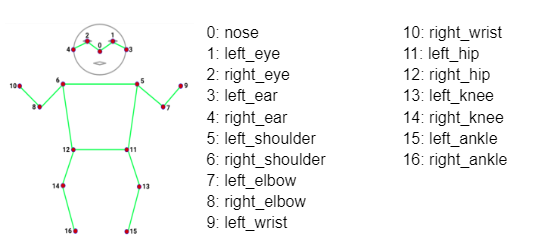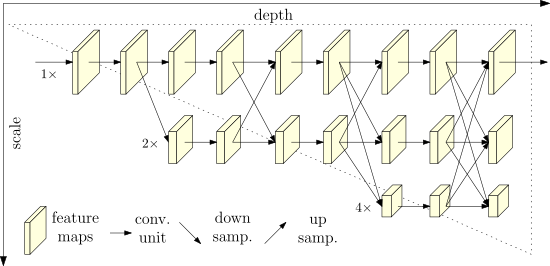
Pose Estimation In Computer Vision: Everything You Need To Know
Pose estimation is a computer vision task that estimates the position and orientation of a person or object in an image or video. It helps to detect and track key points inside an image or video stream. In this blog post, we will provide a comprehensive overview of pose estimation in computer vision. We will discuss the different approaches to pose estimation, the challenges involved, and the state-of-the-art models, and also cover the wide range of applications of pose estimation.
What is Pose Estimation in Computer Vision?
Pose estimation is a computer vision task that involves estimating the orientation and pose of an object or person in an image or video. It is a challenging task because it requires the model to understand the 3D structure of the object or person, as well as its relationship to the camera. Basically, it provides a solution to the query, "Where is this object, and how is it oriented in space?"
A human body, a mechanical arm, an automobile, or even facial landmarks can be the subject of interest. It offers important details regarding the arrangement and motion of these items which allows computers to comprehend and interact with the real world.
Also Read: Computer Vision Applications in Various Industries
Role of Pose Estimation in Computer Vision
As a key component of many computer vision applications, pose estimation enables computers to better understand and interact with the world. By accurately determining the pose of objects, computers can perceive and interpret visual information, making them smarter and more useful in a wide range of scenarios, such as robotics and automation, augmented reality, and human-computer interaction.
Applications of Pose Estimation
Pose estimation has a wide range of applications in different fields, including:
- Robotics:
The manipulation of objects is a typical robotics activity. Accurate 3D posture estimates are necessary for successful object manipulation in order to position and close the robot's end effector.
- Augmented reality (AR) and virtual reality (VR):
To create realistic and immersive AR and VR experiences pose estimation is essential. Using AR and VR, we can track the movement of users and objects in the real world and overlay digital content onto the real world.
- HealthCare:
Medical applications developed using pose estimates can help diagnose and treat diseases. For example, track the movement of patients during rehabilitation or to analyze the gait of patients with neurological disorders.
- Sports Analytics:
We can analyze the performance of athletes and identify areas for improvement using Pose estimation. This data helps to improve athletic performance, identify areas for injury prevention, and develop new strategies for winning.
- Autonomous Vehicles:
Pose estimation is a technique used by self-driving automobiles to comprehend the location and orientation of nearby objects and move safely.
Type of Pose Estimation Models
Pose estimation is the task of estimating the pose of a person or object in an image or video. To perform pose estimation, you can use a variety of methods, but the three most common types of models are skeleton-based, contour-based, and volumetric models.

1. Skeleton-Based Models
The model represents the human body as a set of connected joints. To train pose estimation models, we typically use datasets of images or videos of people in different poses. Once trained, we can use the model to estimate the pose of a person in a new image or video by identifying the joints in the image and estimating their positions.
Examples of Skeleton-Based Models
Real-time human pose estimation in video games, augmented reality, and security systems.
Used to track the movements of athletes and patients in fitness and medical applications.
2. Contour-Based Models
Contour-based models represent the human body as a set of contours, which are the boundaries of the body and its parts. These models are typically trained on datasets of images or videos of people with their bodies segmented into different parts. Once trained, the model can be used to estimate the pose of a person in a new image or video by identifying the contours in the image and estimating the positions of the body parts.
Examples of Contour-Based Models
Medical imaging to diagnose and treat diseases.
Animation and VFX to create realistic characters and scenes.
3. Volumetric Models
Volumetric models represent the human body as a 3D volume. These models are typically trained on datasets of 3D scans of people in different poses. Once trained, the model can be used to estimate the pose of a person in a new image or video by predicting the 3D volume of the person in the image.
Examples of Volumetric Models
Virtual reality to create immersive experiences.
Autonomous driving to detect and track pedestrians and other vehicles.
How Pose Estimation Works?
Large datasets of photos or videos of individuals in various stances are often used to train pose estimation models. The model gains the ability to recognize important body parts, including the shoulders, elbows, knees, and ankles. The model may estimate the pose of the individual by connecting the key points with lines once the key points have been determined.
Here is a more detailed explanation of how pose estimation works:
Resize the image or video to a consistent size. This is necessary because most pose estimation algorithms are trained on images or videos of a specific size.
Convert the image or video to grayscale. This can simplify the pose estimation algorithm and improve its accuracy.
Normalize the pixel values of the image or video. This means scaling the pixel values to a certain range, such as [0, 1] or [-1, 1]. This can help to improve the convergence of the pose estimation algorithm.
1. Image or Video Preprocessing
The goal of image or video preprocessing is to prepare the input for the pose estimation algorithm. This may involve:
2. Feature extraction
The next step is to take the image or video and extract its features to identify features in the image or video that are relevant for pose estimation. These features may include edges, corners, and key points.
3. Pose estimation
The last step is to estimate the person's stance based on the extracted features. This can be done either by using a deep learning model to directly estimate the pose from the features or by using more traditional machine learning algorithms to estimate the pose from the features.
Once the person's pose has been estimated, the key points can be connected with lines to form a skeleton. This skeleton can then be used to track the person's movements or to infer their 3D pose.

Pose estimation is a difficult task, but recent advances in deep learning have made it much more accurate. Deep learning algorithms can learn complex patterns in the data, which allows them to effectively identify key points on the human body even in difficult conditions such as low light or occlusion.
Models and Libraries Available for Pose Estimation
There are many different pose estimation models and libraries available, each with its own strengths and weaknesses. Some of the most popular pose estimation models include:
1. OpenPose
OpenPose, a computer vision library, and framework created by the Perceptual Computing Lab at Carnegie Mellon University (now a division of Facebook Reality Labs), enables real-time multi-person keypoint recognition and pose estimation from both still images and videos. It is known for its ability to accurately detect and track key points on multiple people's bodies, such as their joints and facial landmarks. You can refer to the GitHub repository for more info.
2. PoseNet
A TensorFlow model for pose estimation that can detect single or multiple poses in real-time. PoseNet is a lightweight, single-person pose estimation model developed by Google AI. It can be run in real-time on mobile devices and outputs the 2D pose of a person in an image or video, represented by 17 key points such as the shoulders, elbows, wrists, hips, knees, and ankles.

In addition, PoseNet was trained on a large dataset of images and videos of people in different poses. The model learns to identify the key points of the human body even in challenging conditions, such as low light or occlusion. It uses the COCO Key point dataset to train its model. Click the link for the GitHub repository.
3. MediaPipe
A cross-platform, open-source machine learning framework for building real-time media pipelines. MediaPipe includes a pose estimation module that can be used to detect single or multiple poses in real-time. This module provides developers with the tools and machine learning algorithms they need to build applications for tasks such as pose estimation, facial recognition, object tracking, and hand tracking.

You can find implementation-related information from GitHub. And you can also find the MediaPipe library using pip commands.
4. HRNet(High-Resolution Net)
An architecture called HRNet is employed for human-pose estimation to identify key points with regard to the particular people or objects in an image. Throughout the process, it maintains high-resolution representations and generates a very precise key point heatmap.

This architecture is also appropriate for identifying human posture in televised sports. HRNet has been useful for a variety of additional dense prediction problems, including segmentation, face alignment, object detection, etc. Here are the documentation and GitHub links to find out more information.
There are many pose estimation solutions available, and the best one for you will depend on your specific needs and requirements. For example, if you need a real-time solution for a mobile app, you will want to choose a model that is lightweight and efficient. If you need a solution for a research project, you may want to choose a model that achieves state-of-the-art results on your benchmark of interest.
Conclusion
Pose estimation is a fundamental task in computer vision with a wide range of applications. It is a challenging task, but deep learning models have achieved state-of-the-art results in recent years. As pose estimation continues to improve, it is likely to play an even greater role in a variety of computer vision applications.
If you want to develop your own pose estimation model in computer vision, we at CodeTrade are happy to help you. Our dedicated AI ML developers are ready to work with you based on your time zone. Contact us now…!